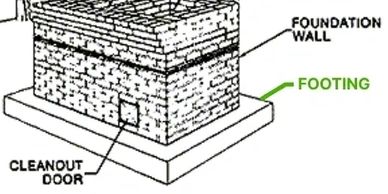Chimney Basics
FOUNDATION
FOUNDATION
FOUNDATION

The foundation of a chimney is typically a poured concrete pad underneath the firebox. If it cracks or breaks, this may result in a leaning chimney. It may be expensive but is necessary to support the chimney’s weight.
FLASHING
FOUNDATION
FOUNDATION

Flashing is found where your chimney meets the roof. It helps protect your chimney from moisture penetration.
It can be made of aluminum, steel, copper or vinyl and it is crucial to have flashing that’s in good condition.
CRICKET
FOUNDATION
CRICKET

A chimney cricket, also called a saddle, helps prevent water leaks between the roof and chimney by diverting the water flow away from the chimney.
STACK
STACK
CRICKET

The bricks are the foundation of your chimney’s stack and if they are not in good condition, your fireplace will not perform well and your home’s safety will be at risk.
Your chimney’s structural integrity will be in question if the brick and mortar are not up to standards.
CROWN
STACK
CROWN

A crown is the slab of concrete that covers the majority of the opening on top of your chimney, where the smoke exits your home.
It is crucial to keep your chimney crown in good condition because it is the main barrier between the outside and your chimney.
CAP
STACK
CROWN

Chimney caps are found on the top of the chimney and protect against rain, snow, debris and even animals from getting into your chimney.
A cap is basically a hat to cover the opening of your chimney, and will often have wiring around it.
CHASE COVER
THROAT DAMPER
THROAT DAMPER

Chase covers can be made from copper, stainless steel, aluminum or galvanized steel. Copper and stainless steel are the more popular options because of their durability and longevity.
Aluminum chase covers have many color options but are not as durable. Galvanized steel can rust, and is more of a short term solution.
THROAT DAMPER
THROAT DAMPER
THROAT DAMPER

The damper is the piece that opens and closes between your fireplace and the chimney. It is best to keep it closed when the fireplace is not in use, to keep drafts out of your home.
When using your fireplace, you need to be able to open your damper to let the smoke out so it does not billow back into your home. If your damper no longer does its job, we can replace it.
FLUE
THROAT DAMPER
CHIMNEY LINER

The interior chimney gets the most attention, as the flue. It is the area where smoke from the fire travels up and out of your home.
Remember to have your flue inspected every year since it can become lined in soot and pose a fire hazard if not taken care of.
CHIMNEY LINER
CHIMNEY LINER
CHIMNEY LINER

Chimney liners encase the walls of your chimney and lead smoke up and out of it. They can be made from aluminum, stainless steel or clay.
Clay liners are the least durable of the three and are usually the original lining of a chimney. When it is time to replace the liner in your masonry chimney, stainless steel is the way to go. It is very versatile, as it can be rigid or flexible to fit perfectly in your chimney. Aluminum liners are used for gas fireplaces only.
SMOKE CHAMBER
CHIMNEY LINER
SMOKE CHAMBER

Just before the flue, the smoke chamber is where smoke first enters on its path to the outdoors.
The Smoke Chamber is an area with sloped walls to help create an easier path for smoke to pass through to the flue. In the chamber lies the smoke shelf which collects any moisture or debris. It can get caked in soot and creosote, so it is important to have it cleaned and inspected yearly.
Family Chimney Repair - Fairview, Oregon
Providing Services in Proximity of : Portland, Salem, Vancouver, Longview, Astoria, Warrenton, Seaside, Canon Beach, Arch Cape, Manzanita, Rockaway Beach, Tillamok, Lincoln City, Newport
familychimneyrepair@gmail.com
Bonded & Insured & Licensed:
Oregon, CCB #244489
Washington, FAMILCR772D7
Copyright © 2025 Family Chimney Repair - All rights reserved.